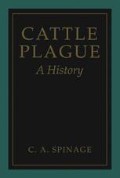Abstract
When rinderpest swept Africa in the 1890s, it was by no means a disease unknown elsewhere, although not clinically diagnosed as rinderpest until it had reached Bulawayo in 1896 almost 8 years after the first reports of its presence (Mack, 1970). When it became clear in South Africa that the construction of a fence to limit animal movements would not check advance of the disease into the European cattle areas, experiments were begun in October 1896 at Marico in the Transvaal with immune serum inoculation by Arnold Theiler, a Swiss veterinarian, and Hubert Watkins-Pitchford, Principal Veterinary Surgeon for the Colony of Natal. Theiler had been operating privately until, in 1893, he was called upon to prepare smallpox vaccine for the Transvaal government. At a conference at Vryburg in August 1896 Watkins-Pitchford stated that the only hope of a remedy was in serum treatment, thus anticipating the breakthrough that was to come. Speaking for the first time at the conference, he exclaimed: “I think all the time spent in administering medicine internally for Rinderpest is not only wasted but very badly spent, the only possible hope of a remedy being in the serum treatment. I do not think any drug would check the disease when the organism is in the blood multiplying there while you are only acting on the alimentary canal.” The serum-virus method of immunization, and the preparation of hyper-immune serum in goats, subsequently provided the control which had eluded workers in Europe for so long. In Bulawayo on March 26, Theiler had telegraphed his government that the Matabele uprising prevented him devising an inoculation against rinderpest, and on his return to Pretoria, he confirmed in a written report of April 10 his readiness to proceed with such work at a location suitably isolated to prevent any spread of infection. Finding Watkins-Pitchford in agreement at the Conference, on his return Theiler was able to persuade the Transvaal Government to take the proposal seriously, huge costs now being incurred by Government in disruption to transport from trek-oxen deaths. On September 13, 1896, Theiler wrote to his parents in Switzerland: “My next task is to devote myself to a series of experiments to determine whether it is possible to combat the. disease with a serum injection. The Government has given me unlimited credit to achieve this object. The Natal Veterinary Surgeon will accompany me and be my coworker” (Gutsche, 1979). The site chosen was Marico in the Rustenberg district, to which Theiler, and Watkins-Pitchford loaned by the Natal Government, departed on October 1, 1896. Seven days later, Dr. Edington, the Colonial Bacteriologist, set forth from Grahamstown on a similar mission for the Cape Colony government to establish himself at Taungs in the northern Cape in a railway coach shunted into a siding. Beginning work on October 14, Edington was assisted by W. Roberstson, J. M’Namara, and J. F. Soga, the last a colored and the first South African to qualify as a veterinary surgeon (at the Royal (Dick) Veterinary College, Edinburgh).
Access this chapter
Tax calculation will be finalised at checkout
Purchases are for personal use only
Preview
Unable to display preview. Download preview PDF.
Rights and permissions
Copyright information
© 2003 Springer Science+Business Media New York
About this chapter
Cite this chapter
Spinage, C.A. (2003). The Breakthrough in Africa. In: Cattle Plague. Springer, Boston, MA. https://doi.org/10.1007/978-1-4419-8901-7_19
Download citation
DOI: https://doi.org/10.1007/978-1-4419-8901-7_19
Publisher Name: Springer, Boston, MA
Print ISBN: 978-1-4613-4712-5
Online ISBN: 978-1-4419-8901-7
eBook Packages: Springer Book Archive

